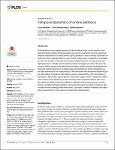Temporal dynamics of online petitions
Böttcher, Lucas
Woolley-Meza, Olivia
Brockmann, Dirk
Online petitions are an important avenue for direct political action, yet the dynamics that determine when a petition will be successful are not well understood. Here we analyze the temporal characteristics of online-petition signing behavior in order to identify systematic differences between popular petitions, which receive a high volume of signatures, and unpopular ones. We find that, in line with other temporal characterizations of human activity, the signing process is typically non-Poissonian and non-homogeneous in time. However, this process exhibits anomalously high memory for human activity, possibly indicating that synchronized external influence or contagion play and important role. More interestingly, we find clear differences in the characteristics of the inter-event time distributions depending on the total number of signatures that petitions receive, independently of the total duration of the petitions. Specifically, popular petitions that attract a large volume of signatures exhibit more variance in the distribution of inter-event times than unpopular petitions with only a few signatures, which could be considered an indication that the former are more bursty. However, petitions with large signature volume are less bursty according to measures that consider the time ordering of inter-event times. Our results, therefore, emphasize the importance of accounting for time ordering to characterize human activity.
Dateien zu dieser Publikation
Keine Lizenzangabe

